In-Depth Examination of iPhone 11 Features
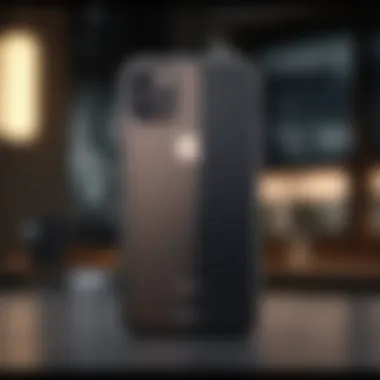
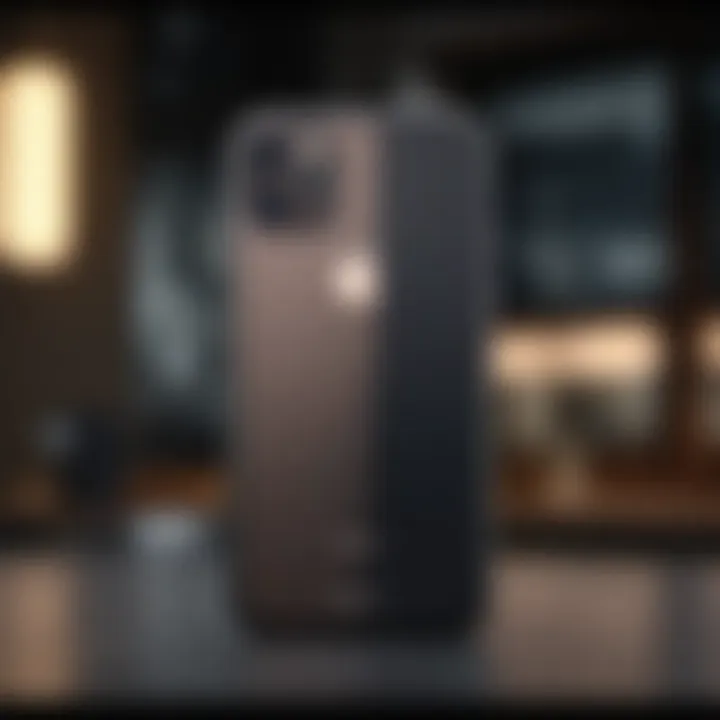
Product Overview
The iPhone 11, launched by Apple in September 2019, is a significant model in the iPhone lineup. It represents a blending of advanced features and competitive pricing, catering to a wide audience. This device is known for maintaining the hallmark quality of Apple products while introducing new functionalities.
Key features and specifications
The iPhone 11 comes equipped with key specifications that enhance both performance and user experience. Powered by the A13 Bionic chip, it offers impressive speed and efficiency. The device features a 6.1-inch Liquid Retina display, which provides vibrant colors and clarity. In terms of photography, the dual-camera system with 12MP lenses enables users to capture high-quality images and videos.
Design and aesthetics
From a design perspective, the iPhone 11 embodies a sleek and modern aesthetic. It is available in six colors: Black, Green, Yellow, Purple, Red, and White. The glass and aluminum construction gives it a premium feel while ensuring durability. The device is rated IP68 for water and dust resistance, enhancing its usability in various environments.
Performance and User Experience
Performance benchmarks
The A13 Bionic chip significantly enhances the iPhone 11's performance. In benchmark tests, it consistently outperforms its predecessors and many competitors. Tasks like gaming, multitasking, and processing heavy applications run smoothly, showcasing the chip's capabilities.
User interface and software capabilities
The iPhone 11 runs on iOS 13, which brings a variety of new features. The user interface is intuitive, making navigation simple. Features like Dark Mode and improved privacy settings have garnered positive feedback from users.
User experiences and feedback
User experiences with the iPhone 11 have been largely favorable. Many users highlight the device's camera quality as a standout feature. The battery life is also commendable, with reports suggesting all-day usage without significant drain.
Comparison with Previous Models or Competitors
Advancements and improvements from previous models
When compared to the iPhone XR, the iPhone 11 showcases improvements in camera capabilities, performance, and software features. For instance, the night mode in the iPhone 11 allows for better low-light photography, which was a limitation in earlier models.
Competitive analysis with other similar products
In comparison with competitors like the Samsung Galaxy S10, the iPhone 11 holds its ground. The photo quality is often cited as superior, particularly in varying light conditions. However, some users might prefer the customizable features of Android.
Value proposition
The iPhone 11 presents solid value for consumers seeking a premium device without venturing into the high-end models. It balances price and performance effectively, making it an attractive option.
Tips and Tricks
How-to guides and tutorials for optimizing the Apple product's performance
To get the most out of the iPhone 11, users can take advantage of settings. For example, adjusting the camera settings can enhance photography. Users should also consider enabling Low Power Mode for extended battery life.
Hidden features and functionalities
Some features may go unnoticed. For instance, the ability to record video in a new QuickTake mode simplifies capturing moments without switching modes. Also, quick access to the camera from the lock screen is a handy trick.
Troubleshooting common issues
Common issues include connectivity problems. Restarting the device often resolves minor bugs. If persistent, a software update may be necessary, ensuring optimal performance.
Latest Updates and News
Recent developments in software updates and new features
As of 2023, the iPhone 11 has seen several software updates introducing new features and performance improvements. Staying updated is crucial for security and functionality.
Industry news and rumors surrounding upcoming products
The tech community often speculates about upcoming Apple releases. Rumors suggest incremental updates rather than revolutionary changes, focusing on enhancing existing technologies.
Events and announcements from Apple
Apple regularly holds events where new products and features are discussed. These announcements often illuminate the direction of future updates for existing products, including the iPhone 11.
Foreword to iPhone
The iPhone 11 represents a significant chapter in Apple’s smartphone evolution. This section outlines its role in the market, focusing on its features and specifications. Understanding the iPhone 11's capabilities is crucial for both consumers and tech professionals aiming to navigate today's mobile technology landscape.
The device was released amidst intense competition. As such, it combines advanced technology with user-friendly features that appeal to a wide range of users. The integration of hardware and software showcases Apple's commitment to its ecosystem, emphasizing seamless user experiences. Analyzing the iPhone 11 provides insights into current trends and future directions in mobile technology.
Overview of the iPhone
The iPhone 11 introduces several enhancements over its predecessors. Launched in September 2019, it features a dual-camera system that improves photography and videography. Additionally, the A13 Bionic chip boosts performance while maintaining energy efficiency. Overall, the design resonates with Apple's aesthetic, curating a device that balances functionality and style.
The display offers clarity and color accuracy, making it effective for media consumption. Battery life, crucial for everyday use, has also seen improvements, allowing users to function longer on a single charge. The iPhone 11 aims to cater to users who desire both performance and durability in their smartphones.
Historical Context
The introduction of the iPhone 11 occurs in the context of rapid smartphone development. Previous models had set high standards for performance and design. The iPhone X and iPhone XS series redefined user interfaces with Face ID and OLED displays. These innovations paved the way for the iPhone 11's launch.
Furthermore, the smartphone market entered an era of sustainability and ethical production. The iPhone 11 aligns with these values by utilizing recycled materials in its construction. Apple has focused on reducing environmental impact while maintaining high-quality standards. By considering the historical context, one appreciates how the iPhone 11 builds upon previous successes while addressing modern concerns and trends.
Design and Build Quality
The design and build quality of the iPhone 11 plays a crucial role in both its aesthetic appeal and functionality. A well-designed device not only attracts consumers but also enhances user experience. Factors such as weight, dimensions, materials, and color options contribute significantly to the overall impression of the smartphone. A thorough understanding of these aspects can illuminate why the iPhone 11 stands out in a competitive market.
Dimensions and Weight
The dimensions of the iPhone 11 are carefully considered to provide an ergonomic grip while still housing an expansive display. It measures 150.9 mm in height, 75.7 mm in width, and 8.3 mm in thickness. The weight is approximately 194 grams.

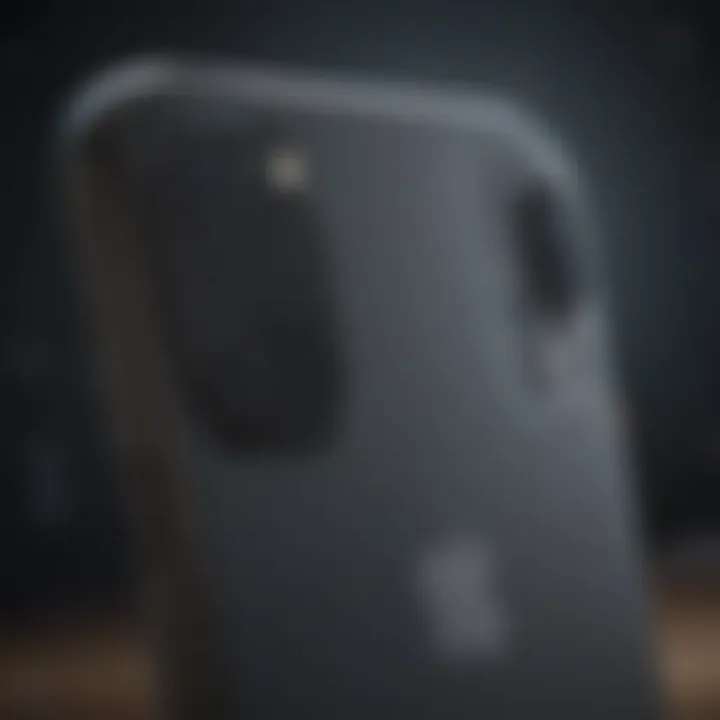
These specifications ensure that the device is neither too bulky nor too light. Holding the iPhone 11 feels balanced, making it comfortable for prolonged use. Users often prefer devices that fit well in their hands and pockets; this iPhone strikes a commendable balance in that regard.
Materials Used
Apple continues to prioritize the use of high-quality materials in the construction of the iPhone 11. The front is protected by Ceramic Shield, which offers enhanced drop performance. The back is made from glass, providing wireless charging capabilities. The aluminum frame adds durability without significantly increasing weight. This combination allows the iPhone 11 to withstand day-to-day wear and tear while maintaining a premium feel.
Moreover, the materials not only enhance the durability of the device but also impact its aesthetic appeal. The glass back allows for various finishes, giving users a choice of elegance that complements their style.
Color Options
Color options for electronics can influence purchase decisions. The iPhone 11 offers six distinct colors: Purple, Green, Yellow, Black, White, and Product(RED). These choices appeal to a range of users, from those who prefer classic shades to those who desire a more vibrant look.
Having diverse color options allows users to express their individuality through their device. The colors also help differentiate the iPhone 11 in a sea of smartphones, allowing it to maintain relevance in a crowded market.
"The design of a smartphone plays as much a role in functionality as in aesthetic appeal; users often judge devices not just by efficiency but also by how they look and feel."
Display Features
The display features of the iPhone 11 serve as a critical touchpoint in both user experience and overall device performance. These elements directly impact how users interact with their phones, influencing functionality across apps, media consumption, and even gaming. Understanding the screen's size, resolution, technology, and brightness helps in grasping the device's competitive edge in a saturated market. When examining smartphones, a strong display often emerges as a defining factor for both consumer satisfaction and engagement.
Screen Size and Resolution
The iPhone 11 comes equipped with a 6.1-inch Liquid Retina HD display. It features a resolution of 1792 x 828 pixels, offering approximately 326 pixels per inch (PPI). This screen size strikes a balance between usability and portability, making it comfortable for one-handed operation while ensuring ample viewing area for multimedia.
The resolution, although lower compared to some of its competitors, retains sharpness in everyday tasks like browsing and app usage. It's important to note that while it may not have the highest pixel density, many users find the visual clarity sufficient for most viewing scenarios.
Display Technology
The Liquid Retina display technology utilized in the iPhone 11 is noteworthy. This IPS technology provides better color accuracy and wide viewing angles. The screen supports a wide color gamut, leading to richer, more vibrant colors. This enhancement is particularly beneficial for activities such as photo editing or watching videos where color fidelity is essential.
Moreover, Apple also includes True Tone technology, which adjusts the display's white balance based on surrounding light. This means that users experience a more natural viewing experience, helping to reduce eye strain over prolonged use. It's a subtle yet impactful inclusion that reflects Apple's attention to detail in user comfort.
Brightness and Contrast Ratio
Brightness is another vital aspect of display quality. The iPhone 11 can reach a maximum brightness of 625 nits, making it suitable for various lighting conditions, including outdoors. This capability enhances visibility, allowing users to interact with their device without straining their eyes, even in direct sunlight.
In terms of contrast ratio, the Liquid Retina technology provides a standard contrast ratio of 1400:1. This ratio ensures that whites appear bright and blacks remain deep, giving depth to images and making them more visually appealing. For users concerned with media playback, these specifications create a rich viewing experience that is capable of highlighting details in both light and dark settings.
"The display quality of a smartphone influences not just aesthetics but also how information is processed by the user, which ultimately affects the overall utility of the device."
In summary, the display features of the iPhone 11 are tailored to provide a visually engaging experience while facilitating ease of use. Through a combination of screen size, resolution, advanced technologies, and brightness capabilities, the iPhone 11 positions itself effectively in a competitive market. These attributes not only support user satisfaction but also enhance productivity and media consumption.
Performance Specifications
Performance specifications play a critical role in understanding the capability of the iPhone 11. They encompass the device's processing power, memory, and efficiency, ensuring it meets the demands of users ranging from casual phone owners to tech enthusiasts and professionals. Evaluating the performance specifications provides insight into how well the device handles applications, multitasking, gaming, and more. Overall, a robust performance is essential for a positive user experience.
Processor Details
The iPhone 11 is powered by Apple's A13 Bionic chip, which marks a significant leap in processing capabilities compared to its predecessors. This chip is built on a 7nm process, enhancing efficiency and performance. It comprises a six-core CPU with two high-performance cores and four efficiency cores. This architecture allows for tasks to be divided between cores, optimizing energy usage while delivering swift performance.
Moreover, the A13 chip features an integrated four-core GPU, enabling advanced graphics rendering suitable for gaming and video playback. The efficiency of the A13 Bionic contributes to the overall fluidity in navigating applications and performing intensive tasks like photo and video editing.
RAM and Storage Options
The iPhone 11 comes with 4GB of RAM. While this may seem modest compared to some competitors, Apple's optimization of iOS ensures that the device runs smoothly. This amount of memory supports the efficient execution of multiple applications and background processes without significant performance dips.
In terms of storage, Apple offers various options: 64GB, 128GB, and 256GB. This range caters to different user needs, from individuals who require minimal storage for basic tasks to those who demand extensive space for multimedia, applications, and documents. Importantly, the lack of expandable storage is a consideration users must weigh when selecting their configuration.
Performance Benchmark Comparisons
To fully grasp the performance of the iPhone 11, benchmark comparisons with rival devices provide valuable context. For instance, various tests conducted on the A13 Bionic indicate it outperforms many Android counterparts in both CPU and GPU tasks. In comprehensive performance tests like Geekbench 5, the iPhone 11 achieves impressive scores, often eclipsing devices running Qualcomm's Snapdragon series.
Additionally, real-world usage scenarios have shown that the iPhone 11 manages tasks such as gaming and video rendering with minimal lag. This efficiency is attributed to its sophisticated cooling system and optimization by Apple, which tends to ensure that the device maintains peak performance across different conditions.
"The A13 Bionic chip not only focuses on raw power but also enhances battery life, making performance sustainable."
By examining these specifications and capabilities, it's clear that the iPhone 11 is designed to deliver an outstanding performance that meets the needs of a diverse audience, ensuring it remains relevant in today's competitive smartphone market.
Camera Capabilities
The camera capabilities of iPhone 11 play a significant role in defining the device's overall experience. In today's smartphone market, an advanced camera system can elevate a phone from being just functional to being a vital tool for creativity and social interaction. The iPhone 11 boasts remarkable camera features that cater to both casual users and photography enthusiasts. Its dual-camera setup, innovative photography modes, and powerful image processing algorithms add to its allure. This section focuses on the various aspects of the iPhone 11's cameras, detailing specifications and capturing functionality that set it apart.
Rear Camera Specifications
The rear camera system on the iPhone 11 includes a 12-megapixel wide lens and a 12-megapixel ultra-wide lens. The wide lens offers an aperture of f/1.8, which facilitates excellent low-light performance, while the ultra-wide lens comes with an f/2.4 aperture and a 120-degree field of view. This combination allows users to capture expansive landscapes and group photos without compromising detail.
The dual-camera setup enables advanced features such as Night mode, which automatically activates in low-light environments, resulting in brighter images with enhanced detail.
In terms of video capabilities, the rear camera supports 4K video recording at up to 60 frames per second. This gives users the flexibility to create high-resolution content suitable for professional use. The rear camera also supports Smart HDR, which intelligently combines multiple exposures to produce well-balanced images with accurate colors.
Front Camera Features
The front camera on the iPhone 11 features a 12-megapixel sensor, offering improved resolution compared to earlier models. It includes an f/2.2 aperture, which provides decent low-light performance. One notable feature of the front camera is its ability to shoot 4K video at 60 frames per second, making it suitable for vlogging and high-quality selfie videos. Additionally, the front camera supports Animoji and Memoji, appealing to users keen on personalized expressions.
Moreover, Smart HDR is also available for the front camera, allowing users to take vibrant selfies even in challenging lighting conditions. This comprehensive suite of features ensures that users get the best out of their selfies and personal videos.
Photography Modes and Image Processing
The iPhone 11 excels in its photography modes, offering various options that cater to different needs. Apart from the regular photo and video modes, users can access Night mode for low-light conditions, Portrait mode for enhanced depth effects, and Slow-motion video capture.
The Smart HDR functionality is critical to the image processing system. It combines multiple exposures for optimal dynamic range, allowing subjects to appear clear against varied backgrounds. The computational photography aspect leverages machine learning to enhance images post-capture.
Furthermore, options like High Key Mono create striking black and white images ideal for portraits.
Battery Life and Charging
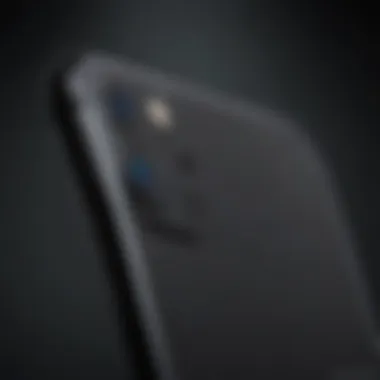
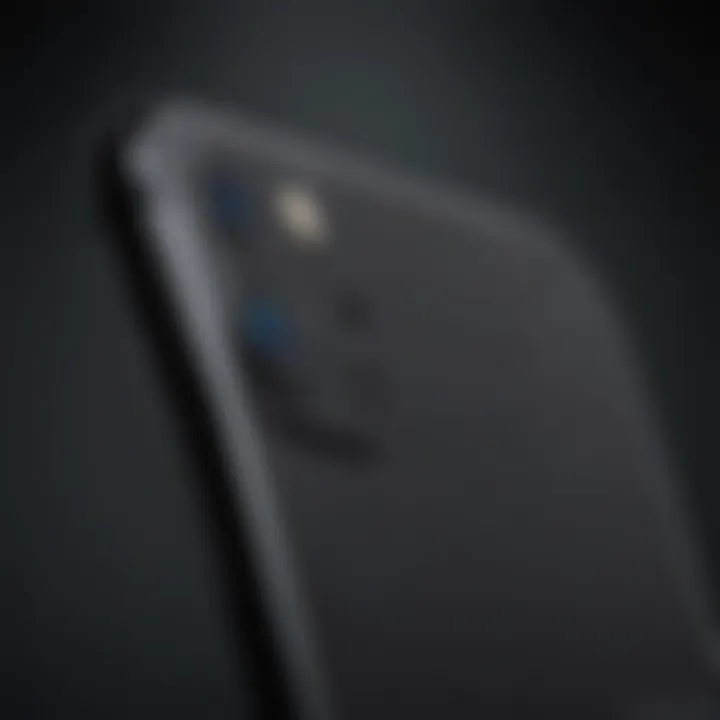
The battery life and charging capabilities of the iPhone 11 play a vital role in its overall functionality and user experience. As smartphones become integral to daily life, the demand for reliable battery performance has increased. Users expect their devices to last throughout the day under various usage conditions. iPhone 11's approach to battery and charging is significant for its users, especially for those who are often on the go and require a dependable source of power.
Battery Capacity
The iPhone 11 is equipped with a battery capacity of 3110 mAh. This increment in capacity compared to its predecessor, the iPhone XR, is a noteworthy feature. Such capacity allows for a longer usage time, making it suitable for activities like streaming, gaming, and multitab browsing without frequent interruptions. The battery is designed to support video playback for up to 17 hours, which is advantageous for users who frequently consume media on their smartphones. With higher capacity, users can maximize productivity without stressing over battery levels. However, the longevity of the battery also heavily relies on software optimizations.
Charging Speed and Methods
Charging speed is crucial for users who wish to recharge their devices quickly. The iPhone 11 supports 18-watt fast charging, allowing users to power the device up to 50 percent in just 30 minutes. This is particularly beneficial for people who are in a hurry and don’t have the time for full charges. Additionally, it is compatible with wireless charging via Qi-certified chargers. While wireless charging offers convenience, it typically charges the phone slower than wired connections. Many users appreciate having the option to choose their preferred charging method based on context only.
Battery Performance in Real-world Use
In real-world scenarios, the battery life of the iPhone 11 proves to be quite effective. User feedback often emphasizes that the phone comfortably lasts a full day on a single charge, even with heavy usage. Activities such as social media, navigation, and video streaming do not substantially drain the battery in a way that would necessitate constant recharging.
Evaluations from various reviews indicate that battery performance under stress is commendable. When utilizing power-hungry applications, users still report decent remaining battery life at the end of a demanding day. This performance reliability stems from both hardware specs and the efficiency of the iOS system. Some users warrant that with the right power management settings, the battery life can stretch even further.
"The iPhone 11 excels in balancing between performance and battery endurance, which resonates well with modern users' demands."
Software and User Experience
The software and user experience of a device can shape its overall appeal and functionality. For the iPhone 11, Apple's approach to software design significantly enhances its usability and connects users to robust features that define modern smartphones. This section provides an in-depth evaluation of the operating system, user interface enhancements, and the app ecosystem, illustrating how these elements collectively influence a seamless user experience.
Operating System
The iPhone 11 operates on Apple's iOS 13. This operating system introduces various features that contribute to a smooth and intuitive user experience. Significant updates include revamped privacy settings, a dark mode, and improved performance efficiencies. The operating system handles multitasking with ease, allowing users to switch between applications without notable lag.
Regular updates from Apple keep the device secure and up to date with the latest features. iOS 13 supports capabilities like enhanced photo editing tools and more versatile navigation with Swipes. The importance of such an operating system cannot be overstated, as it directly affects user satisfaction and device longevity.
“The performance of an operating system can either elevate or hinder the user experience of a smartphone.”*
User Interface Enhancements
Apple continuously refines its user interface to ensure accessibility and ease of use. In the iPhone 11, the user interface has streamlined functions, making it simple for users of all experience levels to navigate. Key enhancements include gesture-based controls and modifications to the home screen design that simplify app access.
Moreover, the addition of the Quick Actions feature allows users to perform tasks without delving into deeper menus. Features like Haptic Touch provide tactile feedback, enhancing interactions. Such refinements are pivotal for delivering an efficient and enjoyable user experience, resonating well with both tech enthusiasts and casual users alike.
App Ecosystem
The app ecosystem surrounding the iPhone 11 is a cornerstone of its user experience. With millions of applications available on the App Store, users can personalize their devices according to individual needs and preferences. Popular applications like Spotify, Instagram, and Microsoft Office integrate seamlessly into the operating system, taking full advantage of its features.
Apple has also emphasized security within its app store, ensuring that user data remains protected while providing access to a myriad of functionalities. The ecosystem provides essential tools for productivity, entertainment, and education, marking it as a significant factor in the relevance of the iPhone 11 in today’s smartphone market.
Connectivity Options
Connectivity options play a vital role in any smartphone's usability, and the iPhone 11 is no exception. In a world where seamless communication and accessibility are paramount, the ways in which a device connects to the outside world are essential for users. They enable the device to make phone calls, browse the internet, stream content, and interact with other devices. This section delves into the wireless connectivity features and SIM network capabilities that define the iPhone 11's connectivity landscape.
Wireless Connectivity Features
The iPhone 11 incorporates several advanced wireless technologies aimed at enhancing user experience. It supports Wi-Fi 6, which is also known as 802.11ax. This standard is a significant upgrade from its predecessor, allowing for faster data rates, better performance in congested areas, and improved power efficiency. Users can expect quicker downloads, smoother video streaming, and more reliable connections, especially in environments with many devices.
Bluetooth 5.0 is another feature supported by the iPhone 11. This version allows for increased range and speed compared to older Bluetooth technologies. It enables better connectivity with wireless accessories like earbuds and smartwatches, making the iPhone 11 versatile for various users’ needs.
In addition, the device supports NFC for Apple Pay, allowing users to make secure payments with a simple tap. This highlights its focus on convenience and security in financial transactions.
"Wireless connectivity is not just a feature; it's a necessity in today's mobile landscape."
SIM and Network Capabilities
When it comes to SIM and network capabilities, the iPhone 11 features dual SIM functionality, allowing for personal and business lines to coexist. The device supports a physical nano-SIM card alongside an eSIM, which offers flexibility and convenience. Users can switch between different plans without the need for multiple devices. This feature particularly appeals to frequent travelers who might wish to avoid roaming charges by using local SIM cards.
Network capabilities include support for 4G LTE in a range of bands, ensuring users can access high-speed data services virtually anywhere. The device also provides excellent voice call quality, aided by features like Voice over LTE (VoLTE), which enhances voice clarity during calls.
Audio and Video Features
The audio and video features of the iPhone 11 play a crucial role in its overall performance and user experience. Analyzing these aspects provides insights into how Apple integrates multimedia technology into its devices. The importance of sound and visual capability cannot be underestimated, especially for users who frequently consume content or engage in multimedia production. Key factors such as speaker quality, video playback resolutions, and compatibility with various formats significantly enhance device utility. Users are inclined towards devices that offer immersive audio and pristine video clarity.
Speaker and Sound Quality Analysis
The speaker quality in the iPhone 11 is a significant improvement over its predecessors. It features stereo speakers providing a more balanced audio experience than mono speakers. This enhancement allows for clearer sound reproduction, which is essential for multimedia consumption such as watching movies or listening to music.
Users have noted that the audio output is rich with detail. The increased volume levels also add to the experience without compromising clarity. The integration of spatial audio further enhances this feature, allowing sound to feel dynamic and immersive. Users experience a surround sound effect, which is beneficial for gaming or when watching high-definition content. High-quality audio output can be crucial during video calls as well, making communication more effective.
- Pros
- Cons
- Enhanced stereo sound
- Clear and rich audio output
- Spatial audio support for immersive experience
- Limited low-end response compared to dedicated speakers
In summary, the speaker and sound quality of the iPhone 11 meet the expectations of those who prioritize audio fidelity. While portable speakers may offer deeper bass, the iPhone 11 delivers a remarkably solid performance for a handheld device.
Video Playback Specifications
Video playback on the iPhone 11 is another area where Apple excels. It supports a wide range of formats, which is a significant consideration for users who watch diverse content. The iPhone 11 can playback video resolutions up to 4K at 60 frames per second. This feature caters well to users who consume high-quality streaming services such as Netflix or Disney+.
The display technology complements the video performance excellently, providing vibrant colors and sharp details. The device supports HDR10 and Dolby Vision, enhancing the visual experience by presenting higher contrasts and broader color ranges. This enables users to enjoy colors as intended by the creators, adding depth to movies and shows.
Video playback on the iPhone 11, combined with its powerful speaker setup, results in a multimedia experience that rivals larger devices.
Also, the efficient battery management ensures that prolonged video playback does not lead to significant drains on power. Users have found that they can watch movies for hours while maintaining a reasonable battery level.
Security Features
The security features of a smartphone are crucial in protecting users' data and privacy. In the case of the iPhone 11, Apple has implemented several advanced solutions. These features not only enhance the user experience but also build trust with customers. Given the increasing number of cyber threats, focusing on strong security measures is essential.
Face Technology
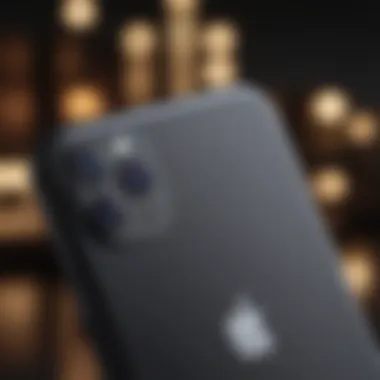
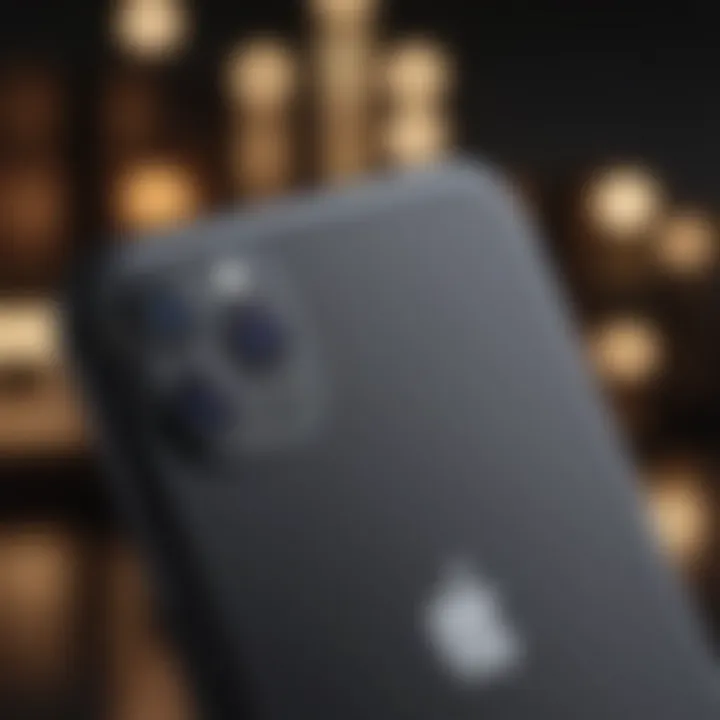
Apple's Face ID technology represents a significant advancement in biometric authentication. Introduced with the iPhone X, it continues to evolve with each new model including the iPhone 11. Face ID utilizes a TrueDepth camera system, projecting over 30,000 invisible dots onto a user's face. This technology captures a detailed 3D map, making it difficult for potential intruders to spoof the system using photographs or masks.
The benefits of Face ID go beyond just convenience. It offers a more secure alternative to fingerprint scanning or passwords. Users can unlock their phones effortlessly, while also ensuring their personal data remains protected. Unlike some biometric systems, Face ID learns and adapts to changes in appearance over time. This adaptability makes it a reliable option for users with fluctuating hairstyles, facial hair, or accessories.
"Face ID is designed to provide maximum security in a seamless manner, ensuring user data can stay private."
Data Encryption Measures
Data encryption measures in the iPhone 11 play a vital role in safeguarding user information. Apple employs strong encryption protocols across the device. By default, all data stored on the iPhone is encrypted using a unique key derived from the user's passcode. This process ensures that even if someone gains physical access to the device, they cannot easily extract personal information.
Apple's approach to security extends to services as well. Sensitive data, such as messages and health information, is encrypted in transit. This means that data sent between devices, like iMessages, remains confidential. Moreover, end-to-end encryption in iCloud ensures that only the user can access their data, rather than anyone at Apple.
The combination of Face ID and robust data encryption measures positions the iPhone 11 as a leader in smartphone security. Apple’s commitment to user privacy resonates with tech enthusiasts and professionals alike, making security features an indispensable aspect of the device.
Pricing and Availability
Pricing and availability are crucial factors in the decision-making process for any consumer. In the case of the iPhone 11, understanding these elements provides insight into its market positioning and accessibility. The costs associated with the iPhone 11 can significantly influence consumer choice, as various configurations offer different specifications at distinct price points. Additionally, availability plays a key role in determining how easily consumers can acquire the device across different regions.
Price Points by Configuration
The iPhone 11 comes in several configurations, each catering to different user needs and budgets. The price varies based on storage options, which are typically 64GB, 128GB, and 256GB. Here’s a brief outline of the pricing structure:
- 64GB Model: This is usually the base model and is priced to attract entry-level users.
- 128GB Model: Offers slightly more storage for a moderate increase in price, making it a popular option for those who store more apps and media.
- 256GB Model: This variant caters to heavy users who need ample storage for photos, videos, and apps, reflecting a higher price range.
A quote from an industry expert: "Having multiple price points ensures that Apple can target a wider audience while maintaining brand prestige."
The pricing strategy not only competes with other smartphones in the market, but also establishes the iPhone 11 as a premium choice with varied options for consumers.
Availability Across Markets
Availability of the iPhone 11 varies depending on the market. Apple has a global reach, but certain features or configurations might not be present everywhere. Key aspects concerning availability include:
- Launch Timeline: The iPhone 11 was launched with a structured timeline in major markets, often prioritizing regions with a robust Apple fan base.
- Retail Partnerships: Availability through various carriers and retailers can influence how quickly customers can access the device. Some regions may offer exclusive deals or bundles that enhance acquisition.
- Import Regulations: In some markets, import regulations may affect how soon the iPhone 11 can be sold. This is crucial for consumers in countries with strict device import laws.
Competitive Landscape
The section on the competitive landscape is crucial for understanding the iPhone 11's place within the market. It provides insights into how Apple’s offerings stack up against both its previous models and rival products. This evaluation does not solely focus on features but also delves into user preferences, technological advancements, and pricing strategies that influence consumer choices.
Comparison with iPhone Models
When comparing the iPhone 11 with its contemporaries, it’s important to note the differences in design, functionality, and price. The iPhone 11 features an A13 Bionic chip, which provides improved speed and efficiency over the iPhone XR's A12 Bionic chip. The camera system is also advanced, with capabilities that surpass what was available in older models. The dual-camera setup on the iPhone 11 ensures better low-light performance and increased versatility in photography.
- Design: The iPhone 11 has a more sophisticated design than previous models. It offers new color options and glass technology for better durability.
- Camera: The comparative analysis shows that while the iPhone 11 retains many aspects of the older iPhones, the enhancement of camera functionalities distinctly sets it apart.
- Battery life: Smaller improvements in battery life can be found, but the real difference lies in the software optimizations implemented in iOS that extend usability considerably.
Through various benchmark tests, we can see the iPhone 11’s performance aligns closely with other recent models while providing a greater value for money. This makes it an appealing option for users considering an upgrade without entering the higher price tier of the Pro models.
Market Position Relative to Rivals
Apple's iPhone 11 occupies a strategic position in the smartphone market. Against competitors like Samsung Galaxy S10 and Google Pixel 4, the iPhone 11 delivers compelling features that appeal to a wide audience.
- Pricing: It is priced competitively, making it an attractive choice for buyers who want premium features without the added cost of flagship counterparts.
- Ecosystem: The integration of the iPhone with other Apple products enhances its desirability. Users of MacBook or iPad benefit from seamless connectivity and productivity capabilities that are often unmatched by rival ecosystems.
- User Loyalty: Apple's strong brand loyalty, solidified through years of reliable hardware and innovative software, keeps its market position robust against emerging technologies and competitors.
According to various market research, the iPhone 11 has contributed significantly to Apple's retained market share, particularly in regions where premium smartphones are gaining popularity. > "The iPhone 11 has redefined expectations for mid-range smartphones and set a benchmark that competitors aim to meet."
Analyzing the competitive landscape reveals key insights for potential buyers. The iPhone 11 not only stands as a worthy investment for those in Apple's ecosystem but also offers significant advancements that justify its purchase over earlier devices and rival brands.
User Reviews and Feedback
User reviews and feedback play a crucial role in assessing the iPhone 11's market reception and real-world performance. Understanding user experiences can illuminate aspects that are often overlooked in technical specifications and marketing materials. This section seeks to highlight user opinions regarding the device, focusing on their significance, strengths, weaknesses, and the overall reception in the tech community.
Aggregate Review Scores
The aggregate review scores typically reflect an overall consensus regarding a product’s performance and user satisfaction. The iPhone 11 has received positive feedback across various platforms, including Reddit and product review sites. Most reviewers tend to highlight its advanced camera abilities, long battery life, and improved processing power. On a scale of 1 to 10, many scores hover around the 8 to 9 range, indicating a favorable reception.
A breakdown of some sources shows a majority of consumers giving high ratings, particularly for:
- Camera Quality: Offers solid performance in low light conditions and excellent color accuracy.
- Battery Life: Generally noted to surpass expectations, lasting through full days of moderate to heavy usage.
- Software Performance: The seamless interaction with iOS 13 has impressed many users, making it one of the top-rated features.
This data allows potential buyers to gauge whether the iPhone 11 meets their needs effectively compared to alternatives in the market.
Common Praise and Critiques
While user reviews are predominantly positive, they also reveal common areas of criticism that potential users should consider. Among the praise, users often commend:
- User-FriendlyInterface: The ease of use and intuitive design of iOS continues to resonate well with both new and experienced users.
- Performance: Users report fast processing speeds in everyday tasks and gaming, thanks to the A13 Bionic chip.
However, critiques have surfaced as well. Some of the common issues include:
- Price Concerns: While many agree that the features justify the cost, some still feel it is too high compared to competitors offering similar specifications.
- No Major Design Changes: A few users express disappointment regarding the design, claiming it lacks innovation compared to previous models.
The collective feedback of users can guide new buyers in anticipating their experience with the iPhone 11, making it essential data for any analytical breakdown of the product.
End
In examining the numerous features and specifications of the iPhone 11, it is clear that the product embodies a blend of innovation and user-oriented design. Its performance, driven by the A13 Bionic chip, significantly impacts everyday tasks and demanding applications alike. The camera configuration, including night mode and impressive processing capabilities, allows users to capture stunning images under various conditions. Battery life has also shown considerable improvements, enabling prolonged usage without frequent charging.
The importance of these factors is evident when considering the overall user experience. The iPhone 11 provides not only utility but also enhances social connectivity through its integrated features. It becomes more than just a device; it evolves into a tool that shapes communication and entertainment for its users. Furthermore, the seamless software integration enhances interactions, adding layers of functionality that appeal to both casual users and tech enthusiasts.
"The era of smartphones has transformed. The iPhone 11 sets a benchmark in delivering quality features at a competitive price point."
Final Insights on iPhone
The iPhone 11 presents compelling insights into Apple's strategic direction. By maintaining a balance between premium features and affordability, Apple has made this model accessible to a broader audience without compromising quality. Critics often emphasize the strong performance metrics, citing that even after years of use, the iPhone 11 remains competitive against newer models. This aspect reinforces the idea of longevity and relevance in Apple's design philosophy.
From an aesthetic perspective, the iPhone 11 remains visually appealing with its selection of colors and materials. This attention to detail satisfies both consumers who prioritize functionality and those who seek design elegance. Furthermore, its compatibility with the evolving iOS ecosystem ensures that users benefit from updates and support well into the future.
Relevance in Current Market
In today’s saturated smartphone market, the relevance of the iPhone 11 is underpinned by its ability to stand firm against considerable competition from various brands. As companies like Samsung and Google continue to innovate, the iPhone 11 retains its value due to solid performance, robust security features, and a reliable operating system. This continued relevance signifies that choosing an iPhone 11 is a sustainable investment.
The landscape of smartphone technology is always changing. However, the significant focus on user experience, coupled with regular software updates, ensures that the iPhone 11 remains contemporary. As consumers increasingly prioritize longevity and functionality, Apple's offering provides excellent utility at a price that resonates with many. With the growing emphasis on environmental responsibility, opting for a device like the iPhone 11 may appeal to more conscientious consumers seeking durability and functionality across time.



